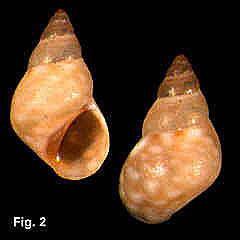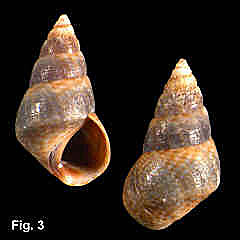|
|
|
|
|
Afrolittorina acutispira (E.A. Smith, 1892) Description: Shell usually eroded, height to width ratio variable, 1.38-1.84. Spire whorls rounded, body whorl rounded (Figs. 1,2) or angled (Fig. 3) at periphery. Surface smooth or sculptured with weak spiral grooves, absent from spire whorls, 11-22 on body whorl when present. Columella smooth; outer lip thin, flared at base. Early whorls dark brown; body whorl fawn or brown, usually with white or grey spots more or less in quincunx; base paler; aperture brown with white streak internally at base. Operculum corneous. Size: Up to 7 mm in length, commonly 2-3 mm. Distribution: Endemic to Australia; Yeppoon, Queensland, southwards to Eden, NSW. Habitat: This species is abundant on rocks on exposed and sheltered shores, from well above high tide down to mid-tide level. It lives on open rock surfaces, in pits and crevices, sheltering among barnacles and in pools, sometimes occurring at very high densities - up to 70,000 individuals per square metre were reported at Botany Bay by Underwood & McFadyen (1983). . Sexes are separate in the Littorinidae, with the male fertilizing the female with a penis on the right side of the head. The female sheds egg capsules into the sea, from which develops a veliger which, in this species, spends 1-2 months in the plankton (McFadyen, 1978). Underwood & McFayden found that in A. acutispira spawning occurs over summer, from October-November to March-April. Juveniles settle out on the shore, and live on microscopic algae on the rock surface. Their growth rate depends on the position they occupy on the shore and the time of year, the availability of food being the controlling factor. Lifespan is 1-2 years, with most individuals dying by 16 months. The animals are remarkably resistant to the harsh conditions high on the rocky shore, even surviving higher than normal temperatures without increased mortality in a laboratory experiment. Synonymy: Littorina infans E.A. Smith, 1892 was applied to small shells with eroded spires. Remarks: This is a well studied species, with the taxonomy discussed by Reid & Williams (2004) and the ecology by Underwood and McFadyen (1983). There is considerable variation in shell form and colour. The height to width ratio varies in the range 1.38-1.84, indicating relatively squat to tall shells. Most specimens have an eroded spire, making the shells take a compact appearance. The colour is variable from dark brown to pale fawn, and from unpatterned to strongly marked. The colour is usually dark brown in the early whorls - hence juvenile shells are dark brown - changing to fawn or light brown on the latter whorls. Shells may be translucent, particularly the lighter coloured specimens. Fig. 1 Long Reef, Collaroy, NSW (C.356998) Fig. 2 Little Coogee Bay, NSW (C.357081) Fig. 3 Bottle and Glass Rocks, Sydney Harbour, NSW (C.114545) |


